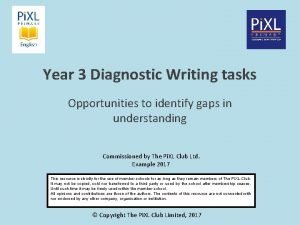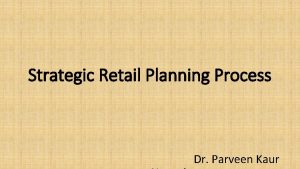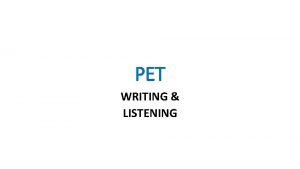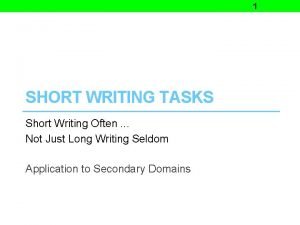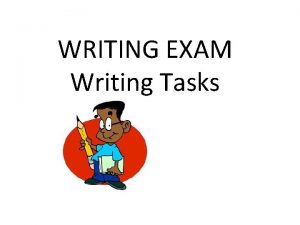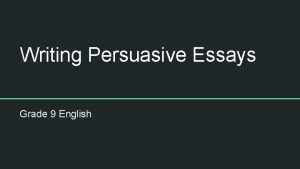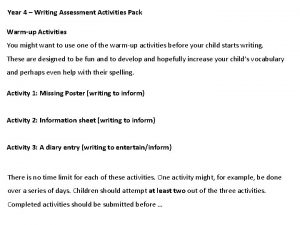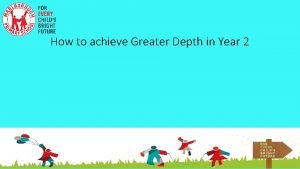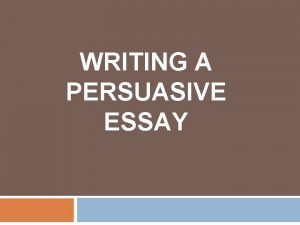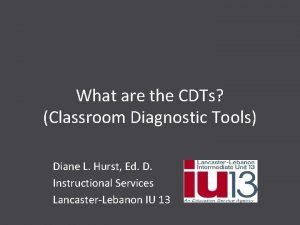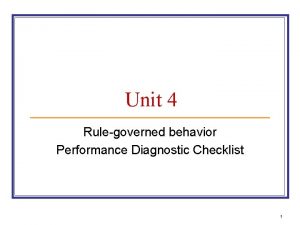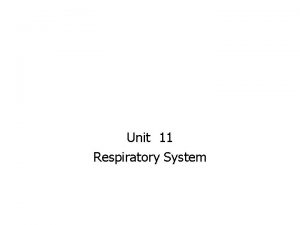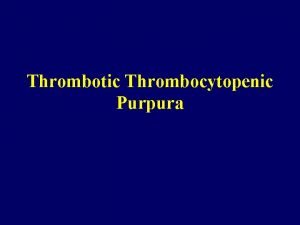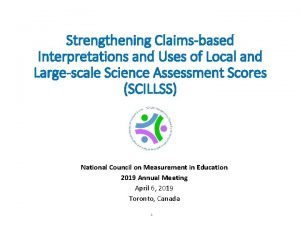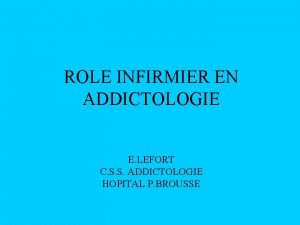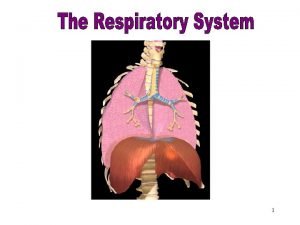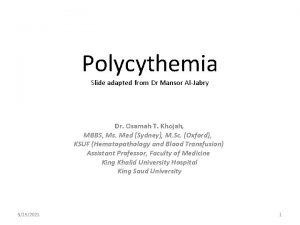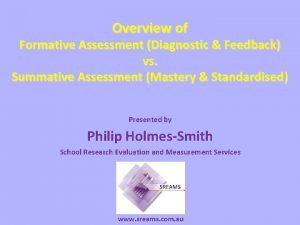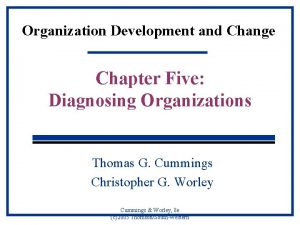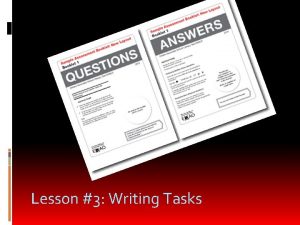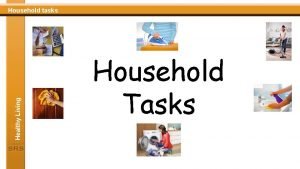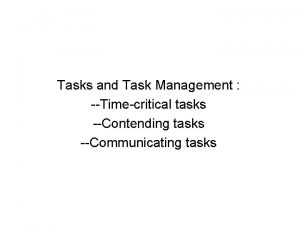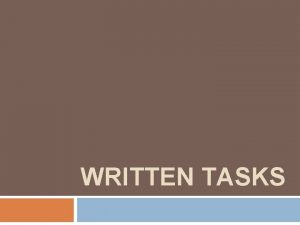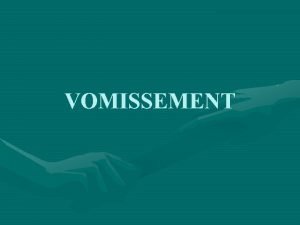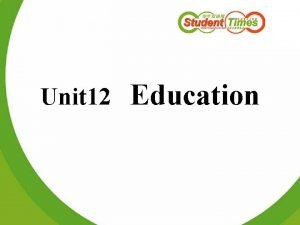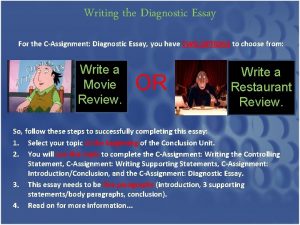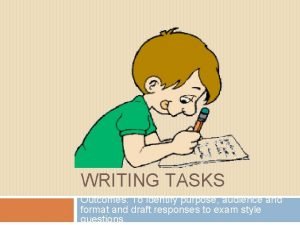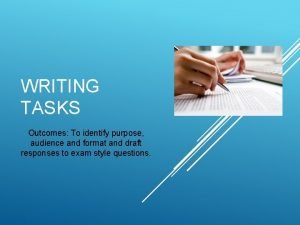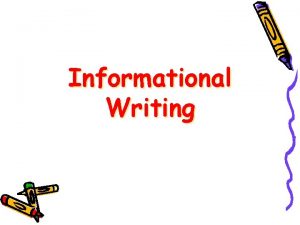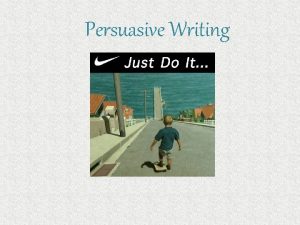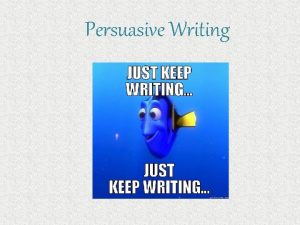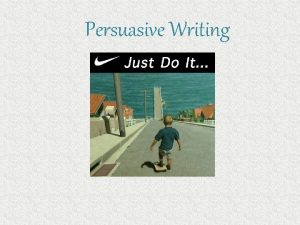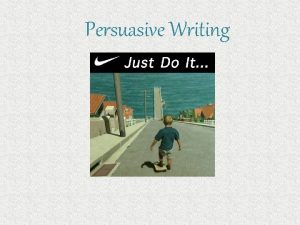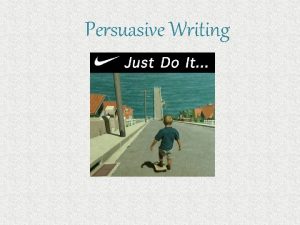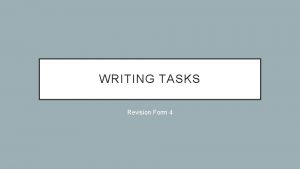Year 3 Diagnostic Writing tasks Opportunities to identify




























- Slides: 28

Year 3 Diagnostic Writing tasks Opportunities to identify gaps in understanding Commissioned by The Pi. XL Club Ltd. Example 2017 This resource is strictly for the use of member schools for as long as they remain members of The Pi. XL Club. It may not be copied, sold nor transferred to a third party or used by the school after membership ceases. Until such time it may be freely used within the member school. All opinions and contributions are those of the authors. The contents of this resource are not connected with nor endorsed by any other company, organisation or institution. © Copyright The Pi. XL Club Limited, 2017

Teacher information These tasks have been designed to give pupils a chance to demonstrate their writing skills in different contexts. They can be used in full or in part and should be viewed as an opportunity to precisely identify the barriers pupils face, which can subsequently be addressed through quality first teaching. Completing some of these tasks should give teachers sufficient opportunity to complete a PLC for individual pupils.

Contents Task 1 Page 4: Tricky Teeth (Instructional writing) Task 2 Page 10: Machinarium (Setting description) Task 3 Page 17: I’m so fed up! (Letter of complaint) Task 4 Page 23: A Very Wet Playtime (Continuing a narrative)

Task 1: Tricky Teeth Greetings me hearties! Captain James Blackmouth here. Blackmouth by name, Blackmouth by nature! My teeth are all rotten and I can’t afford anymore gold ones, so the ship’s dentist tells me I must start brushing them. I haven’t got the foggiest where to begin. Can you help?

Task 1: Tricky Teeth Mission: write a set of instructions which will explain to Captain James Blackmouth how to brush and care for his teeth. Before you write: Can you clearly explain how to brush your teeth? How might a set of instructions be organised? Is there some key language you will need to use?

Task 1: Tricky Teeth After you have written: q Read your instructions aloud. Are they clear and concise? q Look carefully at the different types of punctuation in your writing. Is it placed and used accurately? q Notice the organisational devices you have used. Do they make your text easy to read and follow? q Identify the key language in your writing. Have you chosen precise words to make your meaning clear?

Task 1: Tricky Teeth - Teacher notes Before writing: • Give pupils the opportunity to role play brushing their teeth and describe what they are doing. • Look at a model of a set of instructions for a different activity, noting key language types and organisational devices. • Research good oral hygiene, ensuring children have sufficient content knowledge to undertake the written task. • Orally rehearse what pupils are going to write before they commit it to paper. • Discuss key elements you will be focussing on for individuals.

Task 1: Tricky Teeth - Teacher notes Key questions during writing: • What have you already written? What are you going to write next? • Is it clear to the audience where your sentences begin and end? How did you know you needed to use a , /!/? /’ etc here? • How are you going to begin your next sentence? Why have you chosen that opener? • Can you show me an example of where you have linked or extended a sentence? How did you do this? • What tense are you writing in at the moment? How does the reader know? Have you maintained this throughout your text? • How have you use precise language to madke sure the reader knows exactly what they need to do and how they need to do it? Can you show me where you have done this? • Which organisational devices have you chosen to use? What effect do these have on the reader?

Task 1: Tricky Teeth - Teacher notes Key questions to consider after writing: • What did you find out during your questioning? • What does the finished work/PLC/pupil’s book show you about their writing ability? • Are there other pupils who have similar gaps in understanding? • Do any of these gaps exist for the whole cohort? • Is there evidence that these gaps are inconsistent? • Which is the most important area to tackle first? • What can you change about the writing conditions/environment to ensure that this pupil has the maximum chance of success? • How will this information inform your planning going forwards?

Task 2: Machinarium http: //machinarium. net/ Click ‘Play Free Demo’

Task 2: Machinarium The designers of this game want to write an audio description of this setting to publish on their website. Look and listen closely. Imagine you are there. What can you see/smell/hear/feel/taste? Can you transport the listener to this setting using only your description?

Task 2: Machinarium Mission: write a description which will depict this setting to someone who can’t see the images of it. Before you write: Imagine you are there – consider each sense before you write. How will you ensure your description engages the reader? What key language might you use in your description?

Task 2: Machinarium After you have written: q Read your description aloud. Is it powerful and engaging? q Look carefully at the different types of punctuation in your writing. Is it placed and used accurately? q Notice how each sentence begins. Have you used a range of openers to help your writing flow and link your ideas? q Identify the key language in your writing. Have you chosen precise words to paint a picture for the listener?

Task 2: Machinarium - Teacher notes Before writing: • Encourage pupils to explore the fantasy setting online to immerse them in what they will be writing about. • Look at a model of a setting description and note key language and literary techniques and descriptive writing features. • Give pupils the opportunity to talk about what they can see and record key language that they might want to use in their writing. • Allow pupils time to discuss their ideas and use tools (i. e. word bank, thesaurus, learning wall) to help them orally compose their description. • Give pupils a chance to rehearse what they are going to write before they commit it to paper. • Discuss key elements you will be focussing on for individuals.

Task 2: Machinarium - Teacher notes Key questions during writing: • What have you already written? What are you going to write next? • Is it clear to the audience where your sentences begin and end? How did you know you needed to use a , /!/? /’ etc here? • How are you going to begin your next sentence? Why have you chosen that opener? • Can you show me an example of where you have linked or extended a sentence? How did you do this? • What tense are you writing in at the moment? How does the reader know? Have you maintained this throughout your text? • How have you made sure the reader knows exactly what the setting is like? Can you show me where you have done this? • Which features of descriptive writing/literary techniques have you chosen to use? What effect do these have on the reader?

Task 2: Machinarium - Teacher notes Key questions to consider after writing: • What did you find out during your questioning? • What does the finished work/PLC/pupil’s book show you about their writing ability? • Are there other pupils who have similar gaps in understanding? • Do any of these gaps exist for the whole cohort? • Is there evidence that these gaps are inconsistent? • Which is the most important area to tackle first? • What can you change about the writing conditions/environment to ensure that this pupil has the maximum chance of success? • How will this information inform your planning going forwards?

Task 3: I’m so fed up! You have been attending trampolining lessons after school this term (which are very expensive), but there have been a few problems recently. Your teacher was late for the lesson twice so you didn’t get long on the trampolines. She has also cancelled two classes at short notice. You have been working hard to achieve your next badge, but your teacher keeps forgetting to bring your award. Surely, this can’t continue?

Task 3: I’m so fed up! Mission: write a letter of complaint which outlines your concerns about your trampolining lessons, ensuring that you suggest a suitable resolution. Before you write: Consider the key points that you want to include and how you might organise them. How will you ensure that the reader takes your letter seriously? What key language will you use to help make your points?

Task 3: I’m so fed up! After you have written: q Read your letter aloud. Is the tone firm but fair and are your main points clearly stated? q Look carefully at the different types of punctuation in your writing. Is it placed and used accurately? q Notice how you have organised your writing. Have you used the structure of your letter to make the meaning and intention clear? q Identify the key language in your writing. Have you chosen precise words to reinforce your points?

Task 3: I’m so fed up! Teacher notes Before writing: • Encourage pupils to discuss how they might feel in this case. • Look at a model of a letter of complaint and note key language that is used to create an appropriate tone. • Give pupils the opportunity to explain or role play their grievances and what they want done about them. • Allow pupils to record key phrases and plan their writing, including ideas about what will be included in each paragraph. • Allow pupils time to discuss their ideas and use tools (i. e. word bank, thesaurus, learning wall) to help them orally compose their letter. • Give pupils a chance to rehearse what they are going to write before they commit it to paper. • Discuss key elements you will be focussing on for individuals.

Task 3: I’m so fed up! Teacher notes Key questions during writing: • What have you already written? What are you going to write next? • Is it clear to the audience where your sentences begin and end? How did you know you needed to use a , /!/? /’ etc here? • How are you going to begin your next sentence or paragraph? Why have you chosen that opener? • Can you show me an example of where you have linked or extended a sentence? How did you do this? • What perspective are you writing from at the moment (i. e. 1 st person, 3 rd person etc)? How does the reader know? Have you maintained this throughout your text? • How have you made sure the reader knows exactly what you are upset about and why? Can you show me where you have done this? • What language have you used to create an appropriate tone to this letter? How will this help you to ensure that your complaint is taken seriously?

Task 3: I’m so fed up! Teacher notes Key questions to consider after writing: • What did you find out during your questioning? • What does the finished work/PLC/pupil’s book show you about their writing ability? • Are there other pupils who have similar gaps in understanding? • Do any of these gaps exist for the whole cohort? • Is there evidence that these gaps are inconsistent? • Which is the most important area to tackle first? • What can you change about the writing conditions/environment to ensure that this pupil has the maximum chance of success? • How will this information inform your planning going forwards?

Task 4: A Very Wet Playtime “Not again…” sighed Mina, who was slumped over her desk beside Jack. The rain sploshed and splattered noisily against the classroom window. It had been like this for the whole week. Everyone was bored with the tatty toys and bashed-up books that were dragged out of the dusty, old cupboard when they couldn’t go outside. It seemed as though today was going to be the same as every other day this week, but in the blink of an eye, everything changed…

Task 4: A Very Wet Playtime Mission: Continue writing this story, describing what happened next. Think carefully about balancing dialogue, action and description to ensure that your story grabs the reader, making them desperate to read on. Before you write: Who are the characters and what is the setting like? Do you have a clear idea and sequence for what happens next? Which descriptive writing techniques will you use to engage the reader?

Task 4: A Very Wet Playtime After you have written: q Read your story aloud. Are the key events clearly explained using precisely chosen language? q Look carefully at the different types of punctuation in your writing. Is it placed and used accurately? q Notice how you have created ‘flow’ in your writing. Is it clear what or who you are talking about? q Identify where you have used dialogue to help you tell the story. What impact does this have on the reader and is it balanced well with description?

Task 4: A Very Wet Playtime - Teacher notes Before writing: • Encourage pupils to brainstorm lots of different ideas about what might have happened next. • Give pupils the opportunity to choose one idea and explore/explain it in more detail with a group or partner. • Look at a model of a simple story and note key language that is used to engage the reader. • Allow pupils time to discuss their ideas and use tools (i. e. story maps, planning frames etc) to help them plan out their story. • Allow pupils to record key phrases on their plan, including ideas about what will be included in each paragraph. • Give pupils a chance to rehearse what they are going to write before they commit it to paper. • Discuss key elements you will be focussing on for individuals.

Task 4: A Very Wet Playtime - Teacher notes Key questions during writing: • What have you already written? What are you going to write next? • Is it clear to the audience where your sentences begin and end? How did you know you needed to use a , /!/? /’ etc here? • How are you going to begin your next sentence or paragraph? Why have you chosen that opener? • Can you show me an example of where you have linked or extended a sentence? How did you do this? • What tense are you writing in at the moment? How does the reader know? Have you maintained this throughout your text? • Where have you used dialogue to help you tell the story? Why did you choose to use it here? What else has helped you to tell the story? • Show me an example of where you have deliberately chosen to engage the reader using a specific technique. What impact does this have? Why did you choose this technique?

Task 4: A Very Wet Playtime - Teacher notes Key questions to consider after writing: • What did you find out during your questioning? • What does the finished work/PLC/pupil’s book show you about their writing ability? • Are there other pupils who have similar gaps in understanding? • Do any of these gaps exist for the whole cohort? • Is there evidence that these gaps are inconsistent? • Which is the most important area to tackle first? • What can you change about the writing conditions/environment to ensure that this pupil has the maximum chance of success? • How will this information inform your planning going forwards?
 Writing tasks for year 3
Writing tasks for year 3 What is retail planning process
What is retail planning process Identify strategy
Identify strategy Identify market opportunities
Identify market opportunities Choose one of the tasks
Choose one of the tasks Pet writing
Pet writing Short writing tasks
Short writing tasks Short writing task
Short writing task End of year 6 poem
End of year 6 poem Grade 9 essay examples
Grade 9 essay examples End of diary entry
End of diary entry Spag stands for
Spag stands for How to write conclusion
How to write conclusion Classroom diagnostic tools
Classroom diagnostic tools Pdc pega
Pdc pega University of mn veterinary diagnostic lab
University of mn veterinary diagnostic lab Performance diagnostic checklist
Performance diagnostic checklist Diagnostic test of respiratory system
Diagnostic test of respiratory system Dipyrimadole
Dipyrimadole Applied research in marketing
Applied research in marketing Diagnostic assessment examples
Diagnostic assessment examples Diagnostic report sample
Diagnostic report sample Diagnostic infirmier addictologie
Diagnostic infirmier addictologie Rhinorrhea
Rhinorrhea Diagnostic odds ratio
Diagnostic odds ratio Jugement inique
Jugement inique Polycythemia vera diagnostic criteria 2021
Polycythemia vera diagnostic criteria 2021 Diagnostic feedback definition
Diagnostic feedback definition Organization-level diagnostic model
Organization-level diagnostic model
